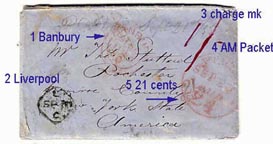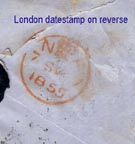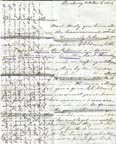Eunice and Ron Shanahan have shared with readers of the Victorian Web this material from their website, Letters from the Past. Click on thumbnails for larger images.
Postal Marks


These postmarks are really interesting. There are 5 on the front and one on the back. The first one is Banbury SE06 1855 the next is on the back and is a London morning duty 7 SE 1855.The manuscript charge of 1/- is in bright red ink would have been applied in Banbury. This was the outgoing ship letter rate for a letter to New York.
It is addressed to Thos. Stutterd, Rochester, Monroe County, New York State America so the next postmark was from Liverpool. This is an unusual one and is listed by Alan Robertson as a transit mark occurring frequently on maritime mail. The date is illegible, but it should be either the 8 or 9 of September as by this time the rail service would have been an efficient run from London to Liverpool.
The next two postmarks are American in red Am.PACKET date stamp showing SEP 20 PAID 24. This cancellation was applied at the New York Exchange office and it was used from 25 May 1851 to 24 January 1856. The British American Postal Treaty of 1848 provided that letters could be carried by either country’s contract steamers for a single postage of one shilling sterling or twenty-four cents, which was to be divided as follows: British inland postage, 1½d or 3 cents; ocean postage 8d or 16 cents, credited to the country providing the steamer; and 2½d or 5 cents. Accounting was to be done on each letter, which could be sent either paid or unpaid, showing the amount of the postage to be credited to or collected from the recipient country. The second one, 21 cents also in red shows 21 cents to be credited to the recipient country, the US, for providing the US packet steamer and inland US conveyance.
It is also possible to work out from the postmarks on which steam packet line, which vessel and which sailing this letter travelled. Of the 5 steam packet services operating in 1855 the only US packet service between New York and Liverpool was the Collins Line. Checking the 1855 Collins Line sailing dates against the postmarks, shows that this letter travelled on the ship Baltic which left Liverpool on 8 September 1855 and reached New York on 19 September 1855.
For centuries Banbury was noted for its ale, cheese, and Banbury cakes, a spiced currant pastry, and in the mid 19th century is was a very busy place as a centre for trade and in the local directory it notes that there were 300 carriers who used the town during any one week, transporting the goods in and out. It is also, of course the site of the nursery rhyme, “Ride a cock horse to Banbury Cross”. The original Banbury Cross, was destroyed by Puritans in 1602 but replaced in 1858.
The Letter
Now to the letter, the contents of which are quite fascinating, and lead to a lot of unanswered questions. It is beautifully written and perfectly legible. The first part of the letter is a shocked response to her brother’s loss, and offering him spiritual comfort. Note the reference to the delivery of the mail to the business.
Dear Brother Thomas
Most truly you have all our sympathy in this bereavement, which it has pleased our Heavenly Father should come upon you and your dear Children. Little did I expect when the Postman put down your letter on our Counter last Thursday that it contained such distressing intelligence. I sent it up to Mary Ann by Mrs Hirons (a woman with one eye) who lives in West Street and was not aware of its contents until M.A came down to business. We were all very much grieved for you and your Children, for her who is gone, we cannot greive, because we feel assured her sorrow and pains are at an end, That now she will be for ever with the Lord & tho you will never again behold her in this world we cannot tell how much she may be employed in watching over you and her Children. “Are they not all ministering spirits, sent forth to minister for them who shall be heirs of salvation.” Dear Thomas she is now a powerful link in the chain which I trust unites you to Heaven, one more tie there, and one less here — so many of our family gone before, we ought to be more anxiously longing to join them, they have laid aside all the infirmities that cling to them here, & only retain what is holy & beautiful, Oh may we love Righteousness & hate Iniquity, use all our diligence to make our calling & election sure that we may have an abundant entrance into the everlasting Kingdom of our Lord & Savior Jesus Christ.
She next explains what has happened at home in England

I had been very uncomfortable the last few weeks, because I had never answered your dear wife’s letters written to me the autumn of last year, when it came my powers of mind & body both were very feeble, so feeble that probably I should not have remembered had not I been reminded & shewn the letters afterwards. I have all the while intended writing, but in consequence of poor Dans illness & death, all the responsibility & harass of the business fell upon me when I was by no means strong enough to bear it.
And then Josephs going away & all the circumstances attending – I longed to write to you, but could not tell what I ought to write & what to leave unwritten. I have often wish’d you here – that you might have the opportunity of judging for yourself how matters stood, though I did not think it possible they could have turned out quite so bad.
An entry in the 1860 Kelly’s Directory for Oxfordshire shows that Mrs E Stutterd was living at 59 High Street Banbury which was listed as a wholesale woollen draper & trimming Warehouse. She must have weathered the storm and made the business successful, with or without her brother in New York.
Poor Mary Ann, no one ever will know all that she has passed thro the last eighteen months & more, she is quite at a loss to know how to act, there is not a doubt but she is the most proper person to superintend your domestic arrangements (all that is left for Mary Ann is the furniture &c and that is not until after Mrs Stutterd’s death, Mrs Stutterd not being able to give her assent to any arrangement adds to the difficulty) don’t you think you could have a mill & do as well here as you are doing at Rochester, I shall be very very sorry to lose Mary Ann, but I know you need her, I cannot advise in any way it must be left between you and herself, may the Lord direct you both.
She broke off the letter then, and later continued to update the situation .
Thursday evening Oct 5th.
Mary Ann has a letter part written, she has been making all the enquiry she can about the Mills in this neighbourhood, but the one she thought most likely for you is let today, so that of course, that door is shut, for the present, this has made her hesitate & she has concluded to let her letter stand over for another week, she sends her very best love to you, I can assure you, you are continually in her thoughts, & she would like to hear from you whether you have any great objection to returning to England, How is your Sister Mary situated, can she take charge of your family, in case Mary Ann cannot extricate herself from the circumstances by which she is surrounded — don’t for a moment think she is indifferent about the matter, very far from it, only it is not always easy to discern the path of duty, I expect she will write by the next Mail, but would like you to write at once & say what you think about coming here, provided any Mill in the neighbourhood was to Let.
The next paragraph is about Cholera, and this description shows how virulent a disease it was. There was a widespread outbreak of the disease in England in 1854, and from this letter, it sounds as though it was in Monroe County, New York State too. The first cholera case did not appear in America until 1832, but there were outbreaks in various States until they managed to get it under control much later in the century.
We all have the idea that Rochester is not very healthy, you have so much Cholera there. Cholera has been very prevalent in this country, this summer in London, Oxford & Towcester it has been very bad, in Silverstone – a village betwixt us and Towcester it has been very fatal, & even we at Banbury are not exempt, we have a new board of Health, & they have been opening drains with a view to improvement, this has caused bad smells &c at the bottom of the town, one poor man named Robinson, who had been carting away the filth was taken suddenly ill last Saturday & died in a few hours, his sister was taken ill on Monday morning & died after seven hours illness, another was taken ill thro working in the Culvert & terminated in Cholera last night, he died in the night, thus you see the scourge is here as well as with you – my Sister Ann, Martha & Ellen send their very kind love to you & all the children, in which I cordially unite
I am your affectionate sister
Eliza Stutterd.
She has then turned back to the first page and written across it with this medical advice for her brother
We are taking Homeopathic medicine as a prevention to Cholera — one Globule of Meratrum at night & one of Cuprum in the morning. I would also advise you to carry a small bottle of tincture of Camphor & a few lumps of sugar in your pocket, or kept it at the Mill as well as at home, & when you have any pain or disorder in your bowels, take 3 or 4 drops on sugar, if you get them from a Homeopathic Chemist, he will give you proper directions as to quantity.
That last paragraph really surprised me, as I had no idea Homeopathic
medicine had been around since the middle of the nineteenth century. I have had
trouble identifying the two medicines she quotes — and they are the
only
two illegible words in the whole letter. However a web search reveals that
Veratrum and Cuprum were used in the treatment of cholera, and camphor
and
mercury were used as preventives, but unluckily people died from mercury
poisoning — another case where the cure is worse than the disease perhaps.
The questions which arise are what kind of Mill would they be looking for, a grain mill, or a cloth mill? Did Mary Ann go over to Rochester to help look after her brother and his children? Did Thomas Stutterd return to Banbury. Perhaps we will ever know the answers.
Bibliography
Walter Hubbard and Richard F. Winter: North Atlantic Mail Sailings 1840-75
BNAPS Transatlantic Study Group Handbook 4.
Alan W. Robertson, The Ship Letter Stamps of Liverpool
Last modified 28 May 2010